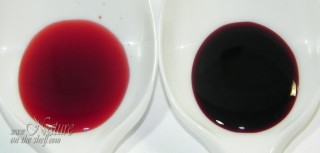Homemade beet root powder
In its root, the beet (Red beet, Beta vulgaris subsp. vulgaris Conditiva) contains a very intense red colorant which is commonly used as a natural color additive in the food industry and cosmetics & pharmaceutical products, representing the main commercial source of natural red food color.
The red color of the beet root comes from a mixture of yellow-orange and red-violet plant pigments called betalains. The principal pigment amongst them is the red colored betanin.

Betalains are water soluble pigments. They are unstable and begin to slowly degrade immediately after extraction from beet cells, under the influence of enzymes, oxygen, and light. Besides that, beet pigments are very sensitive to alkaline environment and high temperature. While they are stable in acidic environment, showing greatest stability at pH 4.5, in alkaline solution (pH 7 and more) they degrade. When exposed to strong alkalis, they degrade almost instantly, changing color to yellow-brown. Beet pigments are sensitive to heat, and begin to degrade at 50oC (122oF), although not so rapidly like in strong alkalis. It is reported that exposure to 100oC (212oF) will destroy more than 80% of red pigments within 3 hours.
The most common forms of beet root colorant on the market are:
- Beet root powder – dehydrated and pulverized beet root
- Beet juice powder – maltodextrin coated with spray dried beet root juice
- Beet root juice – concentrated beet root juice
While beet juice powder and concentrated beet juice are entirely water soluble, dried powdered beet root (the form of beet powder which can be made at home) contains hard particles of beet root tissue, thus it is insoluble in water. Anyway, its red pigment is soluble in water and gets released when powder is mixed with water, coloring the solution red.
Beet juice powder which is commonly offered on the market (like many other herbal extract powders) is dehydrated beet juice, often formulated with maltodextrin. Maltodextrin is a polysaccharide produced from starch and serves as a carrier that converts liquid extract into water soluble fluidy powder. Since it is highly concentrated, this kind of powder has better coloring power than the homemade one, although you will find homemade beet powder to work quite well for many purposes. Also, for some specific purposes, maltodextrin proves to be an unwanted additive.
How to make homemade beet root powder
Peel and grate some beet roots. Some sources found on the Internet suggest previous quick blanching of the beets in order to make them softer and easier to handle. Yet, since heat destroys beet pigments, our suggestion is to avoid any unnecessary heating, that is to say, avoid blanching the beets. Instead, make your beet powder using raw beets. In this way, you will preserve the greatest possible portion of pigments in your beet powder.
Spread the grated beet root in a thin layer on a baking sheet covered with wax paper. Place in the oven and dry at 40-50oC (104-122oF), turn on the oven-fan, and leave the oven door slightly open to allow moist air to escape. It will take 4-5 hours (this depends on how large/small the pieces are). Another convenient way for drying your beet shreds is to use a food dehydrator. Set it at 40-50oC (104-122oF) and dry until they become crunchy.
Grind the dry beet shreds in a coffee grinder and sift to remove any larger particles.
Depending on the purpose, you can additionally make use of a mortar and pestle and sift through nylon stockings to obtain even finer powder.
Keep your beet powder in an air-tight container in a cool, dry and dark place. With time, pigments in the powder will oxidize to yellow-brown color, so you will need to make some new powder.
Properties
Homemade beet root powder is not soluble in either water or oil, but its red pigment is water soluble. This colorant will not perform its best in oil-based formulations because beet-root powder disperses in oils (and eventually sinks to the bottom), but its pigments do not dissolve.

Left image: Beet powder mixed in water (left cup) and in oil (right cup)
Right image: Beet powder mixed in oil (left cup); beet powder mixed in melted, then hardened butter (mid cup); beet powder mixed in softened (but not melted) butter (right cup)
Preparation of macerate
If you want to avoid any hard beet powder particles in your water-based cosmetic formulations, you can extract the pigment by cold maceration in water. Combine 10% (by weight) of powder and 90% of lukewarm (not hotter than 40oC/104oF) water, mix and leave for 30min. Shake occasionally. Filter the mixture through a coffee filter to obtain particle-free red colorant.
Due to dilution of pigment in added water, such a macerate has moderate coloring power.

Uses
Beet root powder can be included in culinary and cosmetic recipes in its powdered form or in form of macerate.
Homemade beet powder can be used as a natural colorant that yields shades of pink to purple-red, depending on the amount used. Due to the properties of its pigments, beet root powder is suitable for use in dry and water-based acidic formulations which do not require further heating after addition of beet root powder. If it is used in a high proportion, a beet taste may become noticeable. In that case, use it in recipes where the beet taste is not important, or where it can be overpowered by other, stronger tastes and aromas.
Some of the examples where beet powder is used: in coloring of fruit yogurts, jellies, ice creams, cold salads, cookie fillings and similar foods and in preparation of handmade cosmetics, for formulation of dry and water-based makeup, facial masks, lotions, shower gels and similar products. Due to degradation of betalains in alkaline environment, beet root powder is not suitable for coloring soap made from scratch (CP, HP), because it will oxidize to tannish-brown color.
